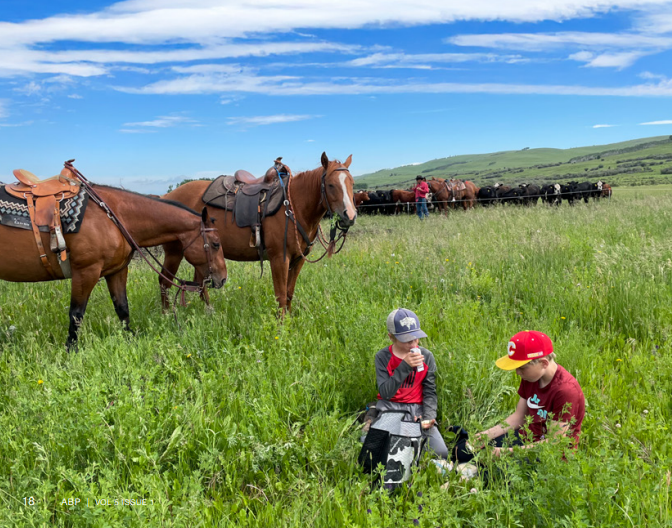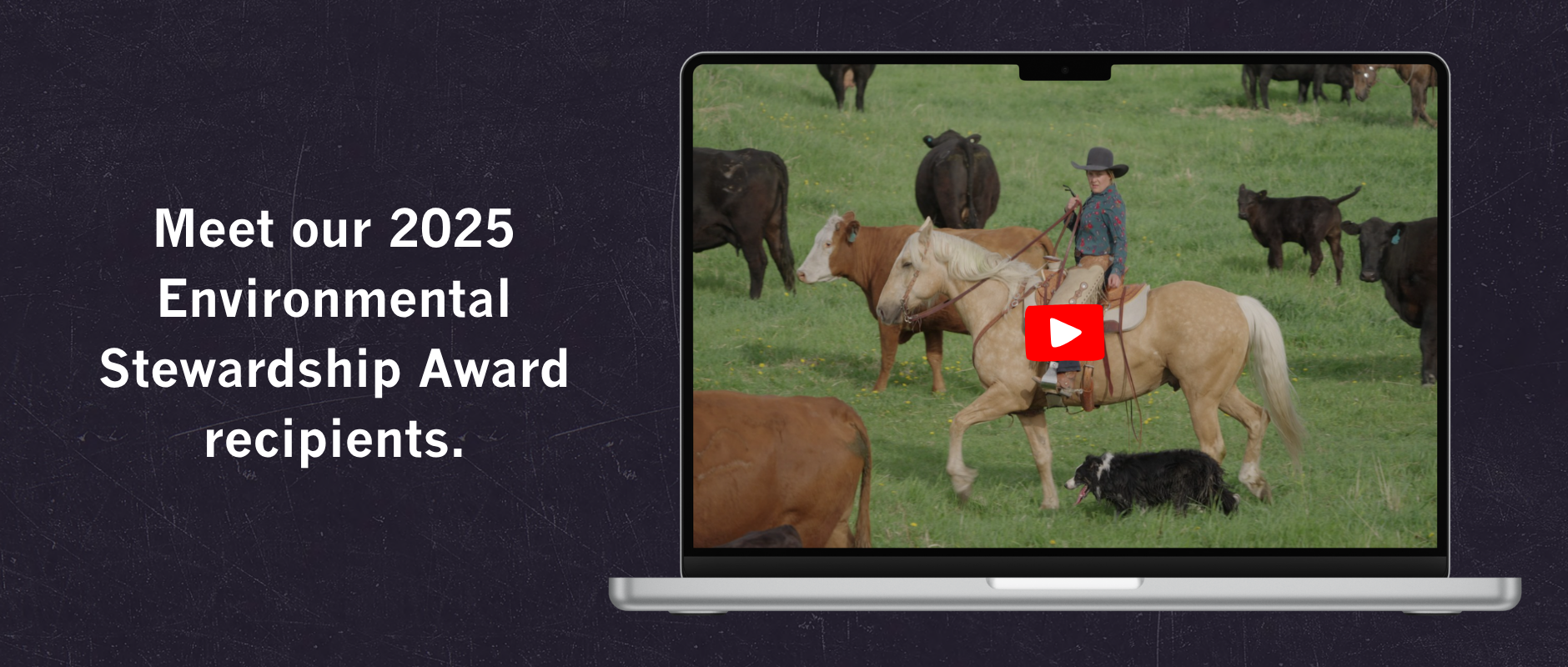AB Direct - Steers
Rail: ---
AB Direct - Heifers
Rail: ---
US Trade- Steers
Rail: 343.00*few (IA)
US Trade - Heifers
Rail: 343.00*few (IA)
Canadian Dollar
0.10

Mt. Sentinel Ranch legacy continues with next generation
Focus on preservation and community sets stage for success
A lot has changed since southwestern Alberta’s Mt. Sentinel Ranch was established in 1898. Still, a few things have remained constant, including the family’s involvement in the operation and their passion for cattle and environmental stewardship.
The family’s legacy in grassland conservation and stewardship began when patriarch Francis Gardner took the helm of the cow-calf operation with his wife Bonnie. “When I look back, I had the most wonderful life because Francis was an enquirer,” says Bonnie Gardner. “He made friends with the young cowboys and First Nations who lived and worked here. He was interested in everything everybody did. He just learned constantly.” Gardner lovingly compared Francis to a computer chip. “He just absorbed information, and then he transposed and simplified it for others,” she says. “He couldn’t be saturated with too much information because he wanted to investigate to see if it was true.”
Since 1971, when Gardner moved from California to Mt. Sentinel Ranch, she has witnessed the sector and society change by leaps and bounds. “We had at least three hired men all the time who lived here on the ranch. We had to forego wages because we had to make sure the help was paid off,” Gardner says. “It’s way more mechanized now, and you can’t afford to have people living on the ranch. The landowner has to pay the going wage everywhere.” At that time, there were no telephones, Highway 22 was a dirt road and Chain Lakes was the end of the road. “We went to Calgary once a month with a Suburban and filled up with groceries for $500 at the wholesalers,” Gardner says. “I fed our workers for 20 years.”
At one point, the family had the beef herd, three milk cows and 50 ewes. “We had kind of a colony right here,” says Gardner. Throughout Francis’s life, his family was involved in numerous research projects and field days to showcase their riparian areas and conservation-based best management practices. They were also part of the province’s first certified organic beef group, Diamond Willow Beef, and helped protect endangered species with the Calgary Zoo. As a result, Mt. Sentinel Ranch received Alberta Beef Producers’ first-ever Environmental Stewardship Award in 1992.
Today, the Gardners’ daughter, Sarah Green, and her husband, Harley, manage the day-to-day operations. For example, Green continues this important conservation work through farm tours and engagement with the Foothills Forage and Grazing Association. Since taking the reins in 2005, Green has installed more water infrastructure to help improve grazing management, ensure cattle health and focus on herd genetics.
Indeed, Gardner has noticed a positive change in the increasing involvement of women in the ranching sector and the evolution of their roles in the business. While she was able to get a degree, travel, work and be involved in the ranch, many women at that time were not afforded such opportunities. “You do the looking after everybody, and you get everything organized, and you go riding with them and stuff, but you still have to get back and do the meals and keep things going here,” Gardner says of ranch life back when she started. “It was kind of a luxury to go to college, and you probably wouldn’t work at all unless your husband died. You weren’t really a major equal in the industry. It was still a man’s world, and women were the supporters.”
Fortunately, during field days that her family has hosted, Gardner has seen daughters return to their families’ ranches and attend events to learn and be decision-makers. Today, she sees Green and Harley operate as a team, along with the help of their two sons. Indeed, Harley manages herd health, Sarah takes care of business administration, and together, they make decisions on long-term grazing plans. “We both really love the cows, improving our genetics and creating a herd that’s as efficient as it can be, quiet and well managed. We both like and find passion in that,” Green says. “I would say my dad was the first generation to really hone in on range management and grassland health and long-term stability and sustainability of the grass. That was really drilled into us our whole childhood. How important that was. I would say that’s my foundation of managing the ranch now.”
That ongoing work in protecting native grasslands is supported in part by the Southern Alberta Land Trust Society (SALTS), a grassroots non-profit that Francis founded with a group of local ranchers in 1998. “It was established because, at the time, provincial and federal governments were looking at ways to encourage the conservation of ranchlands,” says SALTS executive director Justin Thompson. “And a group of ranchers in southwestern Alberta felt that ultimately ranchers and the ranching community were in the best position to work with ranchers around the conservation of grasslands.” Today, the society has about 75 easements that conserve more than 50,000 acres. At their core, conservation easements, facilitated under the Alberta Land Stewardship Act, allow a land trust like SALTS to partner with landowners to voluntarily place restrictions on future non-ranching developments on deeded properties. “It was huge because to this date, SALTS is still really the only rancher-led land trust in Alberta,” Thompson says of Francis’s impact. “His vision, along with the others who started SALTS, has been great because it’s given a bunch of landowners and ranching families the comfort to do a conservation easement because they know that they’re working with an organization that understands what they do.”
Indeed, Thompson adds, pressure is mounting in southern Alberta for further development, subdivision, and recreational activity. More than 25 years ago, SALTS’ founding members were proactive in helping keep ranching landscapes intact. “We are losing these landscapes [that] are not just part of our Alberta identity…but they also provide hunting, fishing and tourism opportunities, clean water. Everybody lives downstream of a lot of these properties,” he says. “And so, all these benefits that come from these well-managed private lands help and provide huge value to Albertans.”
Overall, many ranchers, including Green, want to see these lands protected and conserved for future generations. They can always look to Gardner’s legacy for inspiration and guidance. “As a family, we really want to see the ranch go to the next generation, and the next generation have the same passion for it that we do, but also make it their own,” says Green. “For Harley and I, seeing the ranch continue and seeing this landscape stay intact is probably the most important, as well as enjoying our time here and doing the best we can for the land that supports us.”
This article was first published in Volume 5 Issue 1 of ABP Magazine (February 2025). Watch for more digital content from the magazine on ABP Daily.

